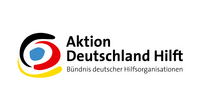
Philippines: February 2014
Against the Storm
Start of a long-term trauma-pedagogic project on the Philippines
On November 8th 2013 typhoon ‘Hayan‘ (storm petrel) or ‘Yolanda‘, which is said to be the most devastating typhoon of all time in the region, struck the Philippines with an unbelievable destructive force. With their many children the Philippines are one of the poorest populations of South-east Asia; and poor families with many children are the ones that were most afflicted by the storm. Mostly, they live in coastal areas and close to river banks, which turn into life-endangering water-floods once a typhoon strikes.
In the Philippines the aftermath of a typhoon is also the precursor of another typhoon. People here are used to natural disasters, this one however has had dramatic impact: The storm had a diameter of 600 kilometers, which corresponds to the longest inner-German East to West route from Düsseldorf to Dresden. More than 6.000 bodies were recovered and more than 2.000 people are still missing. On the island of Leyte about 700.000 houses were destroyed and the city of Tacloban looks as though a Tsunami has passed over it.
Sustained stabilization
Following the first assignment of November 2013 a second assignment was carried out from February 1st to 15th 2014. The work of November 2013 was carried on and a child protection center was built. A team of 13 started their work at a health center close to the airport. Here, emergency- and trauma-pedagogic care for children took place for about a week. At lunch-time a hot meal was prepared for the children. In the afternoon seminars on psycho-traumatology were held for local specialists, who visited from neighboring schools and social institutions. Besides the pedagogical care, longer-lasting structures such as the Child Protection Center could be established, which will help the children cope with their traumatizing experiences. In the course of the first week an empty space was found on which a shelter for children and adolescents could be built. The Friends employed 18 young men from the disaster area who cleared the space and put up tents to lay the ground for this long-term project.
Child-protection center
At the newly built child protection center the pedagogues could work with 100 children in the morning and 200 in the afternoon. 12 educators were employed to continue the emergency pedagogic care after the team of the Friends left the Philippines.
At a closer look, it is clear to see, that the immediate neighborhood of the Child Protection Center is particularly in need of help. Many parents report that besides the devastating typhoon, their homes were struck by a towering, 6 meters high tidal wave. Some escaped onto palm-trees and helplessly had to watch the wave, others made it to the evacuation centers, just in time. Nevertheless, the neighborhood bemoans many losses and many badly injured people still wait for care. Some families have repopulated the places and are beginning to build their homes again.
With some children the shock, which was caused by the traumatizing events of the catastrophe is still obvious, others show other traumatic symptoms such as aggressiveness, lack of concentration, extreme sadness, numbness or hyper-activity. In many cases the clear structures of the child protection center provides stability: A welcome circle, workshops, meals, a fare-well circle. The welcome- and fare-well circle have a ritualizing effect on the daily routine, which is governed by repetitive structures. The main focus of the workshops is a stabilizing effect through providing various means of expressing the traumatizing experience. Movement and rhythm help to put the bodily system, which has was shaken by the traumatizing experience, back in congruence. Another objective can be seen in re-training social rules of engagement, to bolster bodily awareness, and to train self-confidence as well as trust in others. Experiential as well as circus pedagogy, music and arts are the main ways of reaching this goal and they contribute a lot to a joyful atmosphere. Joy is the most important factor when coping with a traumatizing event.
Besides the German team and local volunteers, the team is reinforced by people from all over the Philippines. Many of them had already participated in the first trauma-pedagogic training in Manila in 2013. After this first theoretical introduction they wanted to gain first hand insight into emergency pedagogic work. The emergency pedagogic team met highly motivated people who were already well-equipped with pedagogic skills and are willing to carry on the emergency pedagogic work in the Philippines.
Besides their trauma-pedagogic work, the Child Protection Center is a place where the local community can meet to further build the future of their district. The local team is looking forward to further trainings and wants to establish a long-term Waldorf educational concept for the children of Tacloban.
Emergency-pedagogic training center for pedagogic specialists
Through the exchange with interested personnel, the establishment of local emergency-pedagogic teams, especially in Manila, can be seen. In the long run, a cooperation with the Friends of Waldorf education wants to establish a local job-training center. The Child Protection Center is to be the place of practical training. This structure also lays the ground for further international cooperation of German and Philippine teams in case of another disaster in the South-East Asian region. The development of a world-wide emergency-pedagogic network has taken another step towards providing fast and efficient help in case of emergency.
By Lukas Mall
The Team included: Bernd Ruf (head of mission), Lukas Mall (team-coordinator), Siri Hauser (assistance), Jörg Merzenich (pedagogical head of mission and curative educator), Ulrike Preisser (medical head of mission and doctor), Fiona Bay (nurse), Warja Saacke (Psychotherapist), Sabine Romero (early education trainer), Anna Holz (experiential educator), Katharina Kraul (theater- and circus educator), Peter Sieber (arts therapist), Dorothea Ernst-Vaudaux (eurythmist), Dmitri Vinogradov (eurythmist)


